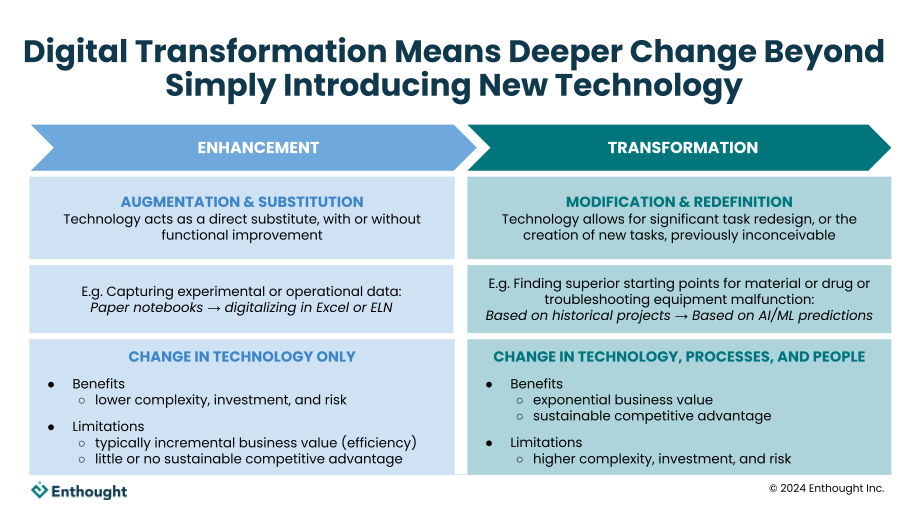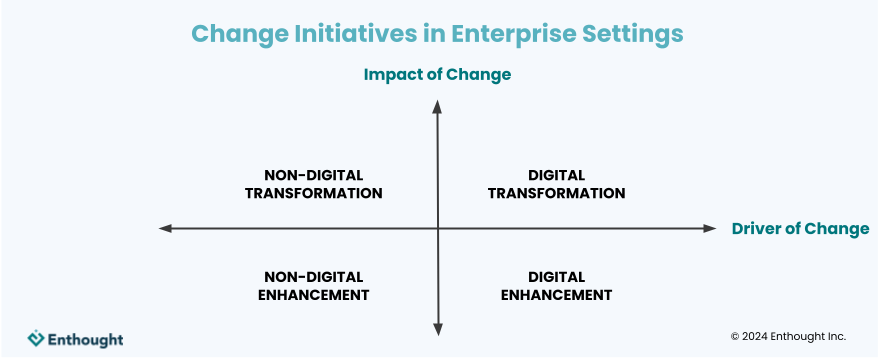Digital transformation is a critical undertaking for science-driven enterprises. The adoption of digital technologies in R&D has proven to provide significant competitive advantage, and companies can no longer afford to hold onto legacy systems and processes. Never has this been more evident than with the advent of generative AI, as it is already revolutionizing how R&D is conducted, leading to new and novel scientific discoveries at an unprecedented pace.
Embarking on a digital transformation journey presents an exciting opportunity for growth and innovation. When armed with a strong strategy and plan, R&D leaders can more effectively navigate the process, ensuring they and their technology initiatives lead to success. This article provides an initial decision framework when developing that strategy so that initiative goals and expectations are aligned.
The 4 Categories of Technology Change Initiatives
To effectively implement digital transformation, it is essential first to understand what it entails and what it does not. Digital transformation is not merely about the implementation of new technologies; it is about fundamentally changing how the work is done to achieve significant improvements in performance and outcomes.
There are actually four main categories of change initiatives related to technology in enterprise settings. As the graphic below shows, digital transformation is not simply a matter of implementing digital technologies. A digital technology might be used for non-transformative purposes, and, conversely, a non-digital technology might be used to produce a major business transformation. The level of impact is determined not solely by the technology as the driver of change but also by the way the technology is used to transform the way work is done (or not).
The first cut is non-digital vs. digital. There are all kinds of non-digital technologies—pencils, typewriters, moving assembly lines, for example. Those are all very valuable non-digital technologies, some of which were transformative in industry. Our focus here is digital technologies, like generative AI.
The second cut is enhancement vs. transformation. Not all digital initiatives, including those involving even the most advanced digital technologies like generative AI, are transformative. Each type of change has different goals, benefits, implications, and most importantly—business value. Recognizing these distinctions helps in setting realistic expectations and aligning decisions and efforts with larger strategic goals.
The Difference Between Digital Enhancement vs. Digital Transformation
Digital Enhancement
A digital enhancement is when a technology is introduced but does not make much change to the way that the work is being done. Many have already experienced an AI enhancement by using an AI note-taking app or ChatGPT to summarize documents or write emails for you. Your IT department may decide to go with an automation SaaS platform that replaces a business unit’s manual data activities. These are clearly great applications of technology; they're highly valuable and accessible—but they're not going to transform your business. Nobody's going to become the next digital unicorn by deploying a note-taking app or replacing manual tasks with a one-size-fits-all software tool.
Commonly, however, incremental digital enhancements are often mistaken for digital transformation and innovation.
Digital Transformation
To capture the much bigger business opportunities that an advanced digital technology represents, in addition to these enhancements, companies also need digital transformations. Using technology for business transformation means not just incremental improvement; it means fundamentally changing the way that your departments and business units do their work. Digital transformation is how to get the bigger and biggest returns.
As shown in the graphic below, transformation goes significantly beyond the incremental improvements of enhancements. In scientific R&D, digital transformation literally changes how science is conducted. By leveraging digital technologies, scientific discovery and innovation are no longer limited by traditional scientific methods. For instance, materials informatics, the innovative combination of data science and materials science and chemistry, can accelerate the materials discovery and development process by decades and more. That is truly transformational and fundamentally changes the trajectory of a business—and a company's position in the market.
Digital enhancements and digital transformation initiatives are not mutually exclusive. In fact, if set up strategically, digital enhancement initiatives can deliver quick wins while contributing to larger transformation over time. This kind of approach provides leaders with an opportunity to pursue the higher reward opportunities represented by digital transformation while reducing the risk that is usually associated with them.

Increasing Success in Scientific R&D Digital Transformation
Digital transformation in any industry is challenging but even more so in scientific R&D. R&D requires consideration of not only the impacts on technology infrastructure, people, and processes but the many complexities around scientific research processes and data.
Unlike the standardized data available in departments like Accounting, scientific R&D data requires specialized handling due to its unique characteristics. To be successful, it is critical to have a deep understanding of both holistic digital transformation strategies as well as expertise in domain-specific data, processes, and concepts, like materials science and chemistry. This intersection is where Enthought excels.
The crucial first step, however, when tasked with digital transformation as an R&D leader is to understand what it is and what it is not. While digital enhancements have their merits, expecting them to have the same results as digital transformation will only result in setbacks and potentially dissuade others from supporting future transformational initiatives. True digital transformation entails leveraging technology beyond augmentation and substitution and provides exponential business value and sustainable competitive advantage.
![]() For more tips on starting your R&D organization's digital transformation journey, check out: 5 Tips to Kickstart Your Journey to the Future-Proofed R&D Lab.
For more tips on starting your R&D organization's digital transformation journey, check out: 5 Tips to Kickstart Your Journey to the Future-Proofed R&D Lab.
Related Content
The Emergence of the AI Co-Scientist
The era of the AI Co-Scientist is here. How is your organization preparing?
Understanding Surrogate Models in Scientific R&D
Surrogate models are reshaping R&D by making research faster, more cost-effective, and more sustainable.
R&D Innovation in 2025
As we step into 2025, R&D organizations are bracing for another year of rapid-pace, transformative shifts.
Revolutionizing Materials R&D with “AI Supermodels”
Learn how AI Supermodels are allowing for faster, more accurate predictions with far fewer data points.
What to Look for in a Technology Partner for R&D
In today’s competitive R&D landscape, selecting the right technology partner is one of the most critical decisions your organization can make.
Digital Transformation vs. Digital Enhancement: A Starting Decision Framework for Technology Initiatives in R&D
Leveraging advanced technology like generative AI through digital transformation (not digital enhancement) is how to get the biggest returns in scientific R&D.
Digital Transformation in Practice
There is much more to digital transformation than technology, and a holistic strategy is crucial for the journey.
Leveraging AI for More Efficient Research in BioPharma
In the rapidly-evolving landscape of drug discovery and development, traditional approaches to R&D in biopharma are no longer sufficient. Artificial intelligence (AI) continues to be a...
Utilizing LLMs Today in Industrial Materials and Chemical R&D
Leveraging large language models (LLMs) in materials science and chemical R&D isn't just a speculative venture for some AI future. There are two primary use...
Top 10 AI Concepts Every Scientific R&D Leader Should Know
R&D leaders and scientists need a working understanding of key AI concepts so they can more effectively develop future-forward data strategies and lead the charge...
